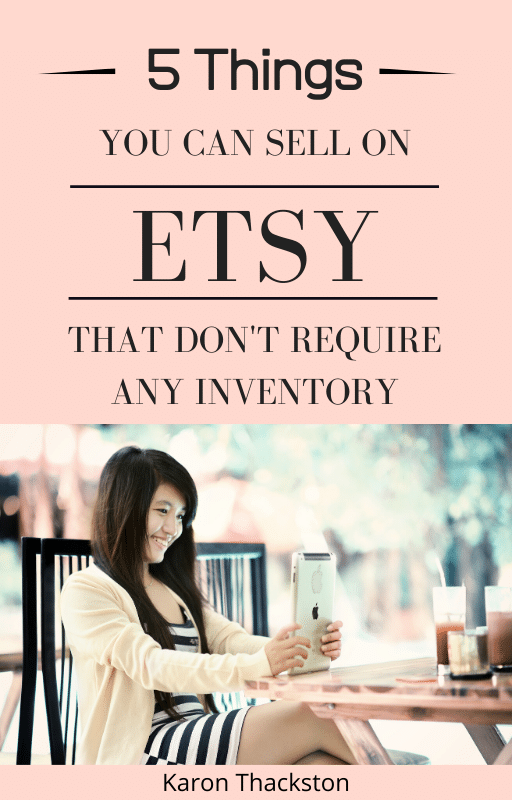
When it comes to passive income strategies, selling digital downloads on Etsy, Amazon and other places is one of the hottest trends going. That’s because it doesn’t take any special skills, printables are quick to produce, and the profit margin is high.
If you’re talking about how to make printables, you want to talk with my friend Amy Harrop who is a true pro. So I asked her to weigh in on this topic and share some useful tips about this easy passive income strategy.
—————————
Creating and selling digital downloads on Etsy or Amazon is one of the easiest ways to build an online business. The benefits of selling printables (digital files people download and print on their own printer) are significant because you have little to no overhead costs, nothing to store, and nothing to ship.
If you’re interested in starting a printables business, you’ve come to the right place. This is your A-to-Z quick start guide for this new passive income strategy. Let’s look at how to make printables to sell on Etsy, Amazon and other sites so you can build a business.
Step 1: Discover What Printables Are?
If you’re new to printables, then the first step is understanding what they are. A printable is a digital download, usually in either a PDF or JPG format. Once a customer buys the printable, they can download and print it at will.
There are many printable formats. Some of the most common include:
- Journal pages
- Planner pages
- Worksheets
- Cheat sheets
- Checklists
- Coloring book pages
- Flash cards
Many printables fall into the category of low-content publishing, meaning that they are typically not densely-printed pages. They include a lot of white space that’s meant to be filled in by the buyer.
Step 2: Learn How To Make Printables
Making printables is easy. I prefer to use the template method where I create a template for a journal page or worksheet and then use it multiple times to create different products. This method provides a short cut for content creation that saves me time and allows me to create multiple products far more quickly than I could if I had to start from scratch each time.
Here are some of my favorite template creation resources:
 PowerPoint. PowerPoint comes with the Microsoft Office Suite. When you create a slide in PowerPoint, it’s very easy to save it as a template or to copy it and create multiple pages in the same document. That’s what I do to create journal or planner pages.
PowerPoint. PowerPoint comes with the Microsoft Office Suite. When you create a slide in PowerPoint, it’s very easy to save it as a template or to copy it and create multiple pages in the same document. That’s what I do to create journal or planner pages.- Microsoft Sway. This is a free tool from Microsoft that you can access online. It comes with dozens of free templates and easy drag-and-drop formatting that you can use to create beautiful templates to reuse.
- Canva. Canva is an online tool with free and premium options. It’s a great place to create things such as calendar pages, journal pages, newsletters, and more. Like Microsoft Sway, it has drag-and-drop formatting and an easy user interface. It’s also great for social media posts.
It may take a bit of trial and error to get your templates to look the way you want them to.
Step 3: Sell Digital Downloads on Etsy, Amazon & More
Once you have created some printables to sell, the next step is deciding where to sell them. In my opinion, Pinterest is the best place to sell printables. It’s the website people turn to when they’re looking for unique images and many Pinterest users seek out planning tools including printables on the site.
Here are a few key things to know about selling printables on Pinterest.
/* .tcb-flex-col { padding-left: 0px; }[data-css=”tve-u-345ecec949e2551″] { width: 100%; float: none; margin: 0px auto !important; padding-right: 0px !important; padding-top: 0px !important; padding-left: 10px !important; }[data-css=”tve-u-15ecec949e2527″] { padding: 20px 20px 0px !important; margin-bottom: 20px !important; }:not(#tve) [data-css=”tve-u-315ecec949e2549″] button { border-color: rgb(85, 85, 85); font-size: var(–tve-font-size, 16px); font-weight: var(–tve-font-weight, var(–g-regular-weight, normal)); background-image: none !important; background-color: rgb(222, 114, 114) !important; font-family: var(–tve-font-family, “Open Sans”); text-transform: var(–tve-text-transform, capitalize); }[data-css=”tve-u-315ecec949e2549″] { –tve-font-size:16px; –tve-font-weight:var(–g-regular-weight, normal); –tve-font-family:”Open Sans”; –g-bold-weight:700; –tve-text-transform:capitalize; }[data-css=”tve-u-285ecec949e2545″]::after { clear: both; }[data-css=”tve-u-275ecec949e2544″] { font-size: 15px !important; }[data-css=”tve-u-105ecec949e2530″] { color: rgb(222, 114, 114) !important; font-family: “Open Sans” !important; font-weight: 400 !important; }[data-css=”tve-u-105ecec949e2530″] strong { font-weight: 700 !important; }:not(#tve) [data-css=”tve-u-95ecec949e252f”] { font-weight: var(–g-bold-weight, bold) !important; line-height: 1.15em !important; font-size: 26px !important; }[data-css=”tve-u-365ecec949e2553″] { float: none; margin-left: auto !important; margin-right: auto !important; }:not(#tve) [data-css=”tve-u-375ecec949e2554″] { font-family: Verdana, Geneva, sans-serif !important; font-weight: var(–g-regular-weight, normal) !important; font-size: 12px !important; }[data-css=”tve-u-135ecec949e2533″] { font-size: 15px !important; }[data-css=”tve-u-175ecec949e2537″] { font-size: 15px !important; }[data-css=”tve-u-195ecec949e253a”] { font-size: 15px !important; }[data-css=”tve-u-215ecec949e253d”] { font-size: 15px !important; }[data-css=”tve-u-235ecec949e253f”] { font-size: 15px !important; }[data-css=”tve-u-255ecec949e2542″] { font-size: 15px !important; }:not(#tve) [data-css=”tve-u-165ecec949e2536″] { font-family: Verdana, Geneva, sans-serif !important; line-height: 1.15em !important; }:not(#tve) [data-css=”tve-u-185ecec949e2539″] { font-family: Verdana, Geneva, sans-serif !important; line-height: 1.15em !important; }:not(#tve) [data-css=”tve-u-205ecec949e253c”] { font-family: Verdana, Geneva, sans-serif !important; line-height: 1.15em !important; }:not(#tve) [data-css=”tve-u-225ecec949e253e”] { font-family: Verdana, Geneva, sans-serif !important; line-height: 1.15em !important; }:not(#tve) [data-css=”tve-u-245ecec949e2541″] { font-family: Verdana, Geneva, sans-serif !important; line-height: 1.15em !important; }}@media (max-width: 767px){[data-css=”tve-u-05ecec949e2523″] { background-image: none !important; }[data-css=”tve-u-335ecec949e2550″] { text-align: center; background-image: none !important; }[data-css=”tve-u-25ecec949e2528″] { background-image: none !important; }[data-css=”tve-u-55ecec949e252b”] { padding-top: 0px !important; }[data-css=”tve-u-45ecec949e252a”] { background-image: none !important; margin-bottom: 0px !important; }[data-css=”tve-u-75ecec949e252d”] { background-image: none !important; }[data-css=”tve-u-15ecec949e2527″] { padding-bottom: 20px !important; margin-bottom: 0px !important; padding-left: 10px !important; padding-right: 10px !important; }[data-css=”tve-u-85ecec949e252e”] { padding: 10px 0px !important; background-image: none !important; }[data-css=”tve-u-295ecec949e2546″] { max-width: 336px; margin-top: 0px !important; padding-top: 0px !important; margin-right: auto !important; margin-left: auto !important; background-image: none !important; }[data-css=”tve-u-345ecec949e2551″] { width: 120px; margin-left: auto !important; margin-right: auto !important; margin-bottom: 10px !important; }}
/*]]>*/
/**/
5 Things You Can Sell On Etsy Today That Don’t Require Any Inventory
Discover products that are:
- Highly Profitable
- Require No Up-Front Investment
- Require No Inventory
- Require No Shipping By You
- Fly Off The Virtual Shelves With Ease

I understand that I will also receive weekly articles & videos plus periodic discounts, product notices & more.
I can unsubscribe at any time.
- It’s best to organize your printables into categories and create boards around them. For example, you might have a wedding planning board that includes wedding planner pages, calendar pages, seating charts and more.
- Each product you list on Pinterest should have a clear image, so customers know exactly what they’re getting.
- Use important keywords in your board names and product descriptions.
However, there are other options.
For example, if you plan to sell educational printables such as worksheets and flash cards, you may want to check out Teachers Pay Teachers. It’s a site where teachers can buy and sell educational materials. You might also want to consider selling your printables on Etsy, Amazon, or your own website.
Keep in mind that selling printables on your own website means you won’t need to pay listing fees. However, it’s also the most challenging option because you’ll be starting without the SEO advantage you’d get from selling on Pinterest or Etsy.
Step 4: Promote and Market Your Printables
Setting up a store is an important step, but you need to make sure that people know about your store and products. That means you’ve got to promote and market your printables. Here are a few things I recommend.
- Set up social media pages for your products. You can grow your following by promoting posts, including social follow buttons on your website, and emailing the people on your list to let them know about your new social media pages.
- Set up a sales page for your printable products. This step is especially important if you plan to sell printables on your website. I suggest making a sales video since research shows that most consumers prefer to learn about new products by watching videos.
- Use Google Ads to promote your sales page and printables. You’ll need to choose the right keywords and target audience, but if you can get that part right, your ads will display to the people who are most likely to buy your printables.
- Offer a freebie. People love free products and one of the best ways to get people to buy your printables is to give them a free taste of what to expect when they do.
- Run a contest. A social media contest is a great way to generate buzz about a product. You can sweeten the pot by offering a discount code to everybody who enters.
Keep in mind that you may need to post the same content multiple times on social media to ensure your followers see it.
Step 5: Scale Printables
The final step is to scale your printables. There are a few ways to do it:

- Create templates to create new products quickly. I already talked about this, but it’s truly one of the quickest ways to scale your printables business.
- Create product bundles. You can and should sell printable pages individually, but you may find that you sell more if you bundle products. People love to feel that they’re getting a bargain.
- Make your products evergreen. Instead of creating journal or planner pages with dates, considering making some with a blank space for the customer to fill in the date. Evergreen products are a great source of passive income because they never go out of date.
- Sell your products on multiple platforms. For example, you might start selling on Pinterest to build up a following and then open an Etsy shop to reach a new audience.
The great thing about printables is that you can create as many products as you want without needing to worry about storage space. It’s the perfect scalable business!

Selling printables is one of the quickest ways I know to earn money online, and my course, Printable Profit Empire, will help you launch and grow your business quickly. Save 30% when you use code PPEMPIRE today.
Have questions about selling printables? Talk to me below!
Other Related Posts You’ll Love
The Power & Profits of Low-Content Amazon Self-Publishing (No Inventory!)
How to Grow Your Passive Income & Affiliate Marketing Income






